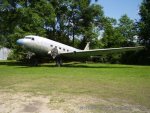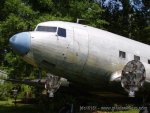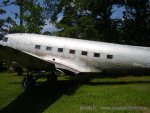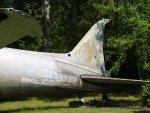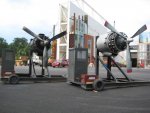If you have access to the plane, there should be a manufacturer's data plate on the outside of the fuselage, near the tail. The tail of an airplane often breaks away from the fuselage in a crash, and also there is (usually) less / no fuel in that area. This means the tail may survive a post-crash fire, even if it does not break away.
The N number should be six digits, 'N' denotes United States aircraft, then 5 numbers/letters. Numbers can't follow letters, so N12A45 would not be a issuable 'N number'.
The N number should also be printed / placarded in the cockpit area on the instrument panel. This is so the pilot can jump in a plane and know how to ID themselves to air traffic control.
Apparently the C47 had stronger landing gear, beefed up flooring, and the large door. As I recall, the DC-3's at Middletown (Miami Valley Aviation) had the wide cargo doors retrofitted to them. Their mission was carrying auto parts to factories to make up for missing/out of spec/broken parts, because the auto factories had gone to Just In Time manufacturing. The planes had small winches (electric ~4000 lb) mounted to the floor at the front to help pull pallets up the floor. With the taildragger arrangement, the cargo area is like a big ramp in there.
The C47's parts can often be used to install on the DC-3's. I don't think that the FAA allowed a C47 to be 'reclassified' as a DC3, but I'm not sure. I noted an article where the factory was able to sell some C47 airplanes as DC-3's, but they'd be able to do that as the manufacturer, by registering them as DC-3's from the outset.
Without the data plates, I think it'd be as hard to tell the DC-3 from a C47 as it would a K5 Blazer and CUCV (after a repaint).
I'd guess DC-3 in that case, with the small rear door. I'd expect that more people would want to add the large door to a DC-3 than to completely eliminate the large door on a C-47. The repair to the skin by the cockpit is pretty obvious, I'd think such a large change in back would be pretty obvious too.


